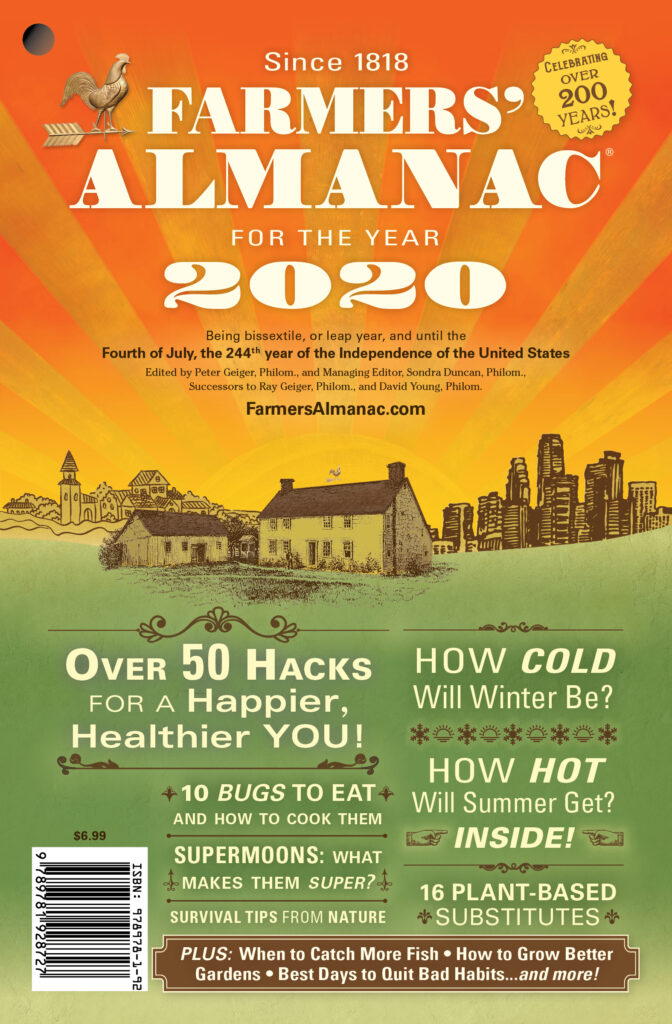Sometimes, we might feel like the world is just too digital, too fast, or even too modern. If Spring 2020 has given us pause to appreciate some of the knowledge that has been lost to the modern world, there is hope. The original Farmers’ Almanac is still going strong.
Some History
The first edition was printed in 1792, based largely on Benjamin Franklin’s model of the Poor Richard’s Almanac. The farmers’ version has been published every year since 1818. In those days, it was a necessity to many because our nation was largely agrarian and the publisher shared knowledge of weather, gardening, cooking, home remedies, managing a household, preserving the earth, and more.

In the early days, those who produced the almanacs were widely respected for their knowledge, and used the title “Philom.” after their names. Both Ben Franklin and David Young, Founding Editor of the Farmers’ Almanac, used the title.
Today, while we don’t all have farms, or hunt and fish, the Almanac still provides generations’ worth of observation, home remedies, recipes, and the kind of common-sense wisdom that never loses its relevance.
Some say it is equal parts science, wisdom, and folksy nonsense; e.g., “expect thundery weather.” But that also makes it the perfect book to have around the house. Back in 1919, with appropriate feedback, the publisher even began selling it with a hole in the upper corner so readers could hang it on a hook in the outhouse for entertainment. The 2020 edition still has the hole.
While it does not have the volume and flexibility of a modern Wikipedia, it does include modern-day life hacks and all manner of passive learning. For instance, you may not even think to do a web search for it, but the Almanac you flipped through this morning told you where you can find sources of Vitamin C in your backyard. Or maybe you weren’t even thinking about doing it, but now you have a recipe, and a craving, for dill pickle cornbread.
*Still* a Thing
Believe it or not, the Almanac is more popular than ever in 2020; with an audience of more than 18 million readers spanning multiple generations. The editors explain; “Smart living never goes out of style. Always close to the earth, always dedicated to living in harmony with nature, and always astonishing readers with amazingly accurate weather predictions.”
In particular, the Almanac has been a perennial authority and advocate of sustainable and green living, which has always been the lifeblood of farming, and is a growth industry in the 21st century. The publisher has also added several social media channels that provide a large portion of the farmers’ wisdom at no cost to their followers. They have 1.2 million Facebook followers, and many more on Twitter, Instagram, and Pinterest, for easy fact-finding feeds any time. Plus, they list nurseries, farmers markets, and other businesses online by zip code.
The 2020 Farmers’ Almanac is available nearly anywhere books and magazines are sold. You can also order a copy online, and businesses can order personal or self-branded versions to share with their own customers.
THE BIG SECRET
The Almanac’s famous long-range weather predictions are made two years in advance.
Almanac forecaster Caleb Weatherbee uses a top-secret mathematical and
astronomical formula, taking sunspot activity, tidal action, the position of the planet, and many other factors into consideration.
Part of the secret himself, Caleb Weatherbee is a pseudonym the Farmers’ Almanac has used, historically and collectively, for all of its forecasters.
The true identity of the prognosticator is as secret as the nearly-two-centuries-old formula for weather prediction.
Longtime readers say Caleb’s predictions are accurate 80-85% of the time.
A TASTE of the good stuff...
- THRIFTY SPONGE TIP • To save money, cut your sponges and
scrubbers in half when you first buy them. They’ll still do a great job and you’ll have double the cleaning tools. - MAY 22nd IS THE BEST DAY TO • Cut Firewood, Mow to Increase Growth, Dig Holes, Host a Party, Travel for Pleasure, Write, Kill Plant Pests
- BUY THESE IN MAY • Asparagus, Radishes, Beets, Rhubarb (late), Broccoli, Strawberries, Brussels sprouts, Turnips, Cabbage, Cucumbers (late), Lettuces & greens, Peas (late)
- HOMEMADE BUG REPELLENT • Large bottle of blue mouthwash, 3 c of Epsom salt, 3 stale beers. Mix together until salt dissolves. Place in spray bottle. Spray perimeter where you are sitting. (Do not drink or spray on yourself!)
